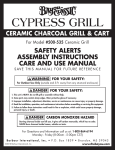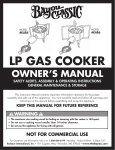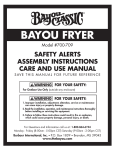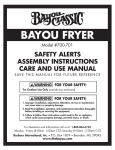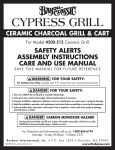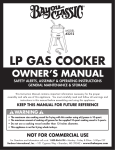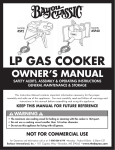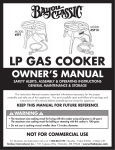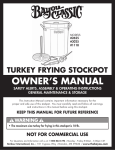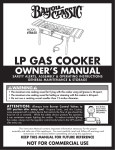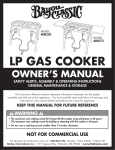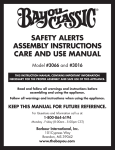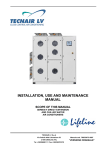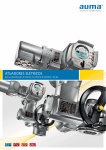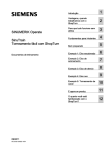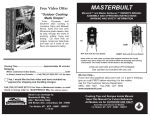Download Bayou Classic 700-709 Owner`s manual
Transcript
MODEL
#700-701
BAYOU FRYER
™
OWNER’S MANUAL
Safety Aler ts, Assembly & Operating Instr uctions
General Maintenance & Storage
This Instruction Manual contains important information necessary for the proper
assembly and safe use of this appliance. Carefully read and follow all warnings and
instructions before assembling and using this appliance.
KEEP THIS MANUAL FOR FUTURE REFERENCE
WARNING
• This appliance does not have automatic thermostat controls so must be attended and monitored
at all times during oil heat up and frying.
• Oil heated above 400˚F can ignite and cause a fire.
• Monitor the thermometer every 3 minutes to ensure cooking oil does not exceed 400˚F.
• Shut off gas if oil exceeds 400˚F or begins to smoke.
• Lid must be open during oil heat up and frying.
• In case of fire; close lid, turn off gas and call Fire Department.
• Do not attempt to extinguish an oil/grease fire with water.
• Surface of the appliance is extremely hot.
NOT FOR COMMERCIAL USE
For Questions and Information call us at: 1-800-864-6194
Barbour International, Inc.
•
101 Cypress Way
•
•
Monday - Friday 8:00am - 5:00pm CST
Brandon, MS 39042
•
www.thebayou.com
CONTENTS
Warnings & Dangers
1-8
Assembly Instructions
9
Thermometer Testing and Attachment
10
Positioning the Fryer
16
Lighting Instructions
17
Re-igniting Burner; Turning off the Fryer
18
19
Regulator Hose Asssembly
13
How to Determine Proper Amount of Oil
for Cooking
Connecting Regulator Hose Assembly
to Burner
13
Frying Instructions
20 - 21
Cooking Oil: Important Facts to Know
21 - 22
Connecting Regulator Hose Assembly
to LP Gas Cylinder
14
Care and Storage Maintenance
22 - 23
Trouble Shooting Tips and Guide
23 - 24
LP Gas Cylinder Specifications
Gas Leak Testing
11 - 12
14 - 15
If you have a missing or damaged part, please do not return
this item to the store.
Call Barbour International, Inc. for assistance:
1-800-864-6194
Monday-Friday 8:00am - 5:00pm CST
LIMITED WARRANTY
Barbour International, Inc. ("Vendor") warrants to the original retail purchaser of this gas fryer/cooker and no other person, that if this gas fryer/cooker is
assembled and operated in accordance with the printed instructions accompanying it, then for a period of one (1) year from the date of purchase, all parts
in such gas fryer/cooker shall be free from defects in material and workmanship. Vendor may require reasonable proof of your date of purchase from an
authorized retailer or distributor. Therefore, you should retain your sales slip or invoice. This Limited Warranty shall be limited to the repair or replacement
of parts, which prove defective under normal use and service and which Vendor shall determine in its reasonable discretion upon examination to be defective.
Before returning any parts, you should contact Vendor's Customer Service Department using the contact information listed below. If Vendor confirms, after
examination, a defect covered by this Limited Warranty in any returned part, and if Vendor approves the claim, Vendor will replace such defective part without
charge. If you return defective parts, transportation charges must be prepaid by you. Vendor will return replacement parts to the original retail purchaser,
freight or postage prepaid.
This Limited Warranty does not cover any failures or operating difficulties due to accident, abuse, misuse, alteration, misapplication, improper installation
or improper maintenance or service by you or any third party, or failure to perform normal and routine maintenance on the gas fryer/cooker, as set out in
this owner's manual. In addition, the Limited Warranty does not cover damage to the finish, such as scratches, surface chips and cracks, discoloration, rust
or other weather damage, after purchase.
This Limited Warranty is in lieu of all other express warranties. Vendor disclaims all warranties for products that are purchased from sellers other that authorized
retailers or distributors. AFTER THE PERIOD OF THE ONE (1)-YEAR EXPRESS WARRANTY, VENDOR DISCLAIMS ANY AND ALL IMPLIED WARRANTIES,
INCLUDING WITHOUT LIMITATION THE IMPLIED WARRANTIES OF MERCHANTABILITY AND FITNESS FOR A PARTICULAR PURPOSE. FURTHER, VENDOR
SHALL HAVE NO LIABILITY WHATSOEVER TO PURCHASER OR ANY THIRD PARTY FOR ANY SPECIAL, INDIRECT, PUNITIVE, INCIDENTAL, OR CONSEQUENTIAL
DAMAGES. Vendor assumes no responsibility for any defects caused by third parties. This Limited Warranty gives the purchaser specific legal rights; a
purchaser may have other rights depending upon where he or she lives. Some jurisdictions do not allow the exclusion or limitation of special, incidental or
consequential damages, or limitations on how long a warranty lasts, so the above exclusion and limitations may apply to you.
Vendor does not authorize any person or company to assume for it any other obligation or liability in connection with the sale, installation, use, removal,
return, or replacement of its equipment, and no such representations are binding on Vendor.
NOTE TO CONSUMER
This LP Gas Cooker is a specialized high pressure gas appliance having greater heat output than traditional
kitchen stoves. It is referred to as fryer and appliance in this manual and on warning tags. Same as a
kitchen stove, this appliance does not have automatic thermostat controls so must be attended and
monitored at all times during use.
This appliance is for OUTDOOR USE ONLY, providing multiple cooking options such as frying fish, chicken,
french fries, hushpuppies, onions and wings. This appliance is not to be used to fry whole turkeys.
As with any cooking appliance, care must be taken to follow all Safety Precautions and Instructions in
order to achieve safe and satisfactory cooking results.
Restrict the use of this appliance to adults who can read, understand and follow the warnings and
instructions in this manual, and on the fryer. Safety Alerts alone cannot eliminate the hazards
that they signal. Strict compliance with these instructions, plus common sense operation, are primary
accident prevention measures.
SAFETY SYMBOLS
The symbols and boxes shown below explain what each heading means. Read and follow all
of the safety warnings and instructions contained in this manual and on the cooker.
THE PURPOSE OF THIS SAFETY ALERT SYMBOL
IS TO ATTRACT YOUR ATTENTION
TO POSSIBLE HAZARDS AS YOU ASSEMBLE AND USE THIS PRODUCT.
WHEN YOU SEE THE SAFETY ALERT SYMBOL
PAY CLOSE ATTENTION TO THE INFORMATION WHICH FOLLOWS!
Indicates an imminently hazardous situation which,
if not avoided, will result in death or serious injury.
Hazard or unsafe practices which could result in
severe property damages, personal injury, or death.
Hazard or unsafe practices which could result in
minor personal injury, product, or property damages.
Carefully read and follow all WARNINGS, SAFETY PRECAUTIONS, ASSEMBLY and OPERATING INSTRUCTIONS
contained in this manual and on the cooker.
DO NOT skip any of the warnings and instructions! SAVE THIS MANUAL FOR FUTURE REFERENCE.
WARNING
FOR YOUR SAFETY:
For Outdoor Use Only (outside any enclosure)
1. Improper installation, adjustment, alteration, service or maintenance can cause injury
or property damage.
2. Read the installation, operation, and storage instructions thoroughly before installing
or servicing this equipment.
3. Failure to follow these instructions could result in fire or explosion, which could cause
property damage, personal injury, or death.
1
SAFETY PRECAUTIONS AND WARNINGS
WARNING
This fryer does not have automatic thermostat controls.
Failure to follow these instructions could result in fire or explosion
which could cause property damage, personal injury or death!
ALWAYS
operate in a clear open
area away from buildings,
trees and shrubs.
NEVER
use on decks, boats or
any combustible surface!
OUTDOOR USE ONLY!
Do not operate inside patios,
garages or carports.
NEVER
place flammable or
combustible materials
within 25-ft of fryer.
NEVER
LEAVE APPLIANCE
UNATTENDED!
NEVER
use under any
roof or overhang.
NEVER
NEVER!
close lid when
preheating oil or frying.
let children or pets near
the cooking area
during and after use.
NEVER!
HOT!
ALWAYS
ALWAYS
No barefeet or sandals
when cooking.
Unit is extremely hot during and
after use. Allow 2 hours for unit
to cool down before touching.
Below 115˚F (45˚C)
wear protective mitts, gloves,
and long sleeve clothing
when cooking.
use an accurate thermometer
to monitor temperature when
preheating oil or frying.
Remember: Think Safety and Use Common Sense!
2
WARNING
• This fryer is a high pressure gas appliance for OUTDOOR USE ONLY.
• This fryer does not have automatic thermostat controls so must be attended and monitored
at all times during oil heat up and frying.
• If having any doubts or concerns about your ability to use this appliance call 800-864-6194.
• Should you still have concerns about operating this appliance, then do not use.
Contact your dealer for return and refund.
• The warnings and safety instructions in this manual MUST be followed to provide reasonable
safety and efficiency in using the appliance.
Remember; Think Safety and Use Common Sense!
DANGER
IF YOU SMELL GAS:
1. Shut off gas to the appliance.
2. Extinguish any open flame.
3. If odor continues, keep away from the appliance and immediately call your fire department.
FAILURE TO FOLLOW THESE INSTRUCTIONS COULD RESULT IN FIRE OR EXPLOSION WHICH COULD
CAUSE PROPERTY DAMAGE, PERSONAL INJURY OR DEATH.
DANGER
• Never operate this appliance unattended. A sober, adult must attend and monitor this
appliance at all times during use.
• Keep head, hair and face away from exhaust vent when lighting. A flash flame can emit from the
exhaust vent during initial lighting, igniting hair and clothing.
• Never operate this appliance within 10 feet (3.0m) of any structure, combustible material or other
gas cylinder.
• Never operate this appliance within 25 feet (7.5m) of any flammable liquids.
• Never allow oil or grease to get hotter than 400˚F (200˚C). If the temperature exceeds 400˚F
(200˚C) or if oil begins to smoke, immediately turn the gas supply OFF.
• Heated liquids remain at scalding temperatures long after the cooking process.
Never touch the appliance until liquids have cooled to 115˚F (45˚C) or less.
• If a fire should occur, keep away from the appliance and immediately call your local Fire Department.
Do not attempt to extinguish an oil or grease fire with water.
• Be cautious when in close proximity to any gas appliance. Falling or tripping near the appliance,
or over an appliance hose, may result in the spilling or igniting of oil, potentially causing personal
injury and property damage.
• This fryer is not to be used for frying whole turkeys!
FAILURE TO FOLLOW THESE INSTRUCTIONS COULD RESULT IN FIRE, EXPLOSION OR BURN HAZARD,
WHICH COULD CAUSE PROPERTY DAMAGE, PERSONAL INJURY OR DEATH.
3
WARNING
COOKING WITH OIL OR GREASE
• This fryer does not have automatic thermostat controls so must be attended and monitored at
all times during oil heat up and frying.
• Lid must be open during oil heat up and frying. Closing the lid when frying greatly increases the
potential of over-heating the oil to ignition and fire.
• When cooking with oil/grease, a thermometer must be used. Follow instructions in this manual
for proper installation and use of the provided frying thermometer.
• Follow instructions contained in this manual for proper assembly and positioning of the fryer,
gas leak and thermometer test, heat-up and frying operation, cleanup and storage.
• Cooking oil pre-heat up to over-heat times can vary significantly with relatively small adjustments
to regulator; variable wind, ambient temperature, altitude, starting oil temperature, and type of
cooking oil used. When using 4 1/2 gallons of oil in this fryer, oil preheat time to 350˚F can range
from 10 to 15 minutes.
• Do not allow cooking oil/grease to exceed 400˚F (200˚C) which is the FIRE HAZARD zone on the
thermometer. Cooking oil/grease will ignite and catch fire at 550˚F to 700˚F (287˚C to 371˚C).
• Due to varying heating and cooking times, check thermometer every 3 minutes to ensure cooking
oil does not exceed 400˚F (200˚C). This is an ATTENDED appliance. DO NOT leave appliance
unattended while heating oil/grease, cooking food or cool down period after use.
• Smoking oil is an indication that the oil is too hot and may ignite. Regardless of thermometer
reading, if the oil/grease starts to smoke, turn OFF fuel supply to the burner and
STOP COOKING IMMEDIATELY. This indicates the thermometer is not working properly.
Discard the thermometer and call 1-800-864-6194 M-F 8am - 5pm CST for assistance.
Replacement thermometer Model #5070.
• Never overfill the cooking vessel with oil/grease or water. Follow instructions in this manual for
establishing proper oil/grease level for cooking. The maximum amount for this fryer is 4 1/2 gallons.
• When frying with oil or grease, all food products MUST be completely thawed and towel dried
to remove excess water. Failure to completely thaw and dry foods may cause oil or grease to
overflow from cooking vessel. If ice is present on the food, it means the thawing process is not
complete and may cause a boil over when placed into HOT oil causing a fire and severe burns.
• Never drop food or accessories into hot oil/grease. Wear protective gloves and S-L-O-W-L-Y lower
food and accessories into cooking oil in order to prevent splashing or overflow. Be careful when
removing food from oil. It is hot and could cause burns.
• In the event of rain, snow, hail, sleet or other form of precipitation while cooking with oil,
close the lid and immediately turn off the burner and gas supply. DO NOT MOVE the fryer.
• When cooking with oil/grease, have a BC or ABC type fire extinguisher readily accessible.
• The fryer remains at scalding temperatures long after cooking has ended. Allow appliance to cool
below 115˚F (45˚C) before cleaning or storing. Cool down period varies with the amount of
oil/grease used, wind and ambient temperature.
• Always keep childern and pets away from the cooking area during and after use, until the
cool-down period is completed.
• This appliance is not to be used to fry whole turkeys!
4
DANGER
IF OIL OR GREASE FIRE OCCURS
In the event of an oil/grease fire, do not attempt to extinguish with water. Immediately call your local
Fire Department. A Type BC or ABC dry chemical fire extinguisher may in some cases contain the fire.
If a fire occurs INSIDE THE FRYER VESSEL follow these steps.
• Turn off gas supply.
• Wearing a protective glove, close the lid. DO NOT re-open lid as the oil/grease fire could re-ignite.
Allow fryer to cool down to 115˚F (45˚C) before opening lid.
If a fire occurs OUTSIDE THE FRYER VESSEL follow these steps.
•
•
•
•
•
Turn off the gas supply if possible.
Wearing a protective glove, close the lid if possible.
Call the local Fire Department if property damage is possible.
Attempt to extinguish using a chemical fire extinguisher specified.
Once fire is extinguished, DO NOT re-open lid as the oil/grease fire could re-ignite. Allow fryer to
cool down to 115˚F (45˚C) before opening lid.
WARNING
A. DO NOT store a spare LP cylinder under or near a gas appliance.
B. Never fill the cylinder beyond 80% full.
C. If the information in (A) and (B) are not followed exactly, a fire causing death
or serious injury may occur.
WARNING
PLACEMENT OF FRYER
• This fryer shall be used OUTDOORS ONLY. DO NOT use in a building, home, garage, balcony,
porch, tent or any other enclosed area. Gas appliances shall not be used on or under apartment,
condominium balcony or deck. DO NOT install or use in or on recreational vehicles and/or boats.
• DO NOT operate this Gas Appliance closer than 10 feet (3m) from any combustible materials
including walls or railing, or under overhead construction and tree branches as these materials
could ignite should oil/grease fire occur.
• The fryer must be positioned on a level, stable, noncombustible surface in an area clear of
combustible material. An asphalt surface (blacktop) may not be acceptable for this purpose.
• Do not use on combustible flooring or surfaces such as wooden decks.
• Keep the cooking area clear and free of any combustible material such as household chemicals,
paint, gasoline and other flammable vapors and liquids. Do not store or use gasoline or other
liquid/aerosols with flammable vapors within 25 feet (7.5m) of this fryer.
• Prior to lighting the burner, check wind direction for placement of fryer DOWNWIND from
upright LP cylinder. The fryer must be DOWNWIND and least 20" away from LP cylinder to
keep heat away from cylinder.
• Refer to instructions for Proper Positioning of the fryer on page 16 in this manual.
5
WARNING
THERMOMETER & OIL TEMPERATURE
• This gas appliance does not have automatic thermostat controls so must be attended and
thermometer monitored at all times during use.
• When cooking with oil or grease, a thermometer MUST be used for reasonable temperature
reading. Follow instructions for proper testing, installation and use of the provided thermometer
on page 10 in this manual.
• Test thermometer before each use. If thermometer does not function properly, a replacement
thermometer must be obtained before using this fryer.
• Carefully monitor the temperature of cooking oil with the thermometer and regulate temperature
so it does not reach the "Fire Hazard" zone on thermometer. If necessary, turn the gas OFF
to the fryer to allow the oil to cool.
• Oil ignites at varying temperatures depending on type of oil used, altitude, ambient temperature
and wind. Check thermometer every 3 minutes to ensure cooking oil does not exceed 400˚F (200˚C).
• Do not allow oil or grease to exceed 400˚F (200˚C). Oil or grease will ignite and catch fire.
If cooking oil or grease reaches 400˚F (200˚C), turn burner OFF. Wait for the cooking oil or grease
temperature to decrease to less than 350˚F (117˚C) before relighting burner.
• Regardless of thermometer reading, if the oil/grease starts to smoke, turn OFF fuel supply to the
burner and STOP COOKING IMMEDIATELY. This indicates the thermometer is not working properly.
Discard the thermometer and call 1-800-864-6194 M-F 8am - 5pm CST for assistance.
Replacement thermometer Model #5070.
WARNING
REGULATOR HOSE ASSEMBLY
• The pressure regulator hose assembly supplied with this appliance
must be used. Clean and inspect the hose before each use of the fryer.
If there is evidence of abrasion, wear, cuts or leaks, the hose must be
M5HPR-1
replaced prior to the fryer being put into operation. Only use
replacement regulator hose assembly #M5HPR-1. This part can be obtained by contacting
Barbour International, Inc. at 1-800-864-6194. Replace regulator hose assembly at least every
two years. Keep the fuel supply hose away from any heated surface.
• Refer to instructions for connecting regulator hose assembly to LP gas cylinder and burner on
pages 13 -14 in this manual.
• Check all gas connections by following the Gas Leak Testing Instructions on pages 14 -15 in
this manual. Never test for gas leaks with a lighted match or open flame.
DO NOT operate this fryer with a gas leak.
• Follow Lighting & Reigniting Instructions as stated in this manual on pages 17 -18. Use a fireplace
match or gas appliance butane lighter.
• In sunlight or other bright light, the flame may be almost invisible. Use extreme caution keeping hands,
hair and clothing away from the burner and exhaust vent. Do not lean over the burner when lighting.
Keep hair and face away from exhaust vent when lighting and during use. Loose hair and clothing
can catch fireduring lighting and operation.
• The valve on regulator hose assembly controls flame intensity only. It is not an ON/OFF valve.
6
WARNING
LP GAS CYLINDER
• Use only a 20 pound LP Gas Cylinder or smaller with a protective collar. Never use with natural gas.
• LP (propane) gas is colorless, tasteless, heavier than air, and is both flammable and explosive.
Combustion of propane consumes oxygen and produces carbon monoxide, a poisonous gas.
Therefore, never operate an outdoor gas appliance inside a building or confined area where
ventilation may be restricted. Make sure the LP cylinder and the appliance are placed in an open
area. DO NOT obstruct the flow of combustion and ventilation air.
• Never use a gas cylinder if it shows signs of dents, gouges, bulges, fire damage, erosion, leakage,
excessive rust, or other forms of visible external damage. The cylinder may be hazardous and
should be checked by a qualified liquid propane supplier.
• Never attach a gas cylinder, move or alter fittings while fryer is hot or in operation.
• Do not attempt to disconnect the regulator hose assembly while fryer is in operation.
• When use is complete, always turn the LP cylinder valve OFF first, then turn the regulator control
valve OFF. Turning the cylinder OFF first allows remaining gas to flow out of the regulator hose
assembly before the regulator control valve is turned OFF.
• DO NOT use external electrical sources with this appliance.
• Storage of this appliance indoors is permissible only if the cylinder is disconnected and removed
from the appliance and left outdoors. Cylinders must be stored outdoors out of the reach of children
and must not be stored in a building, garage or any other enclosed area.
• The installation of this appliance must conform with local codes or, in the absence of local codes,
with the National Fuel Gas Code, ANSI Z223.1/NFPA 54, Storage and Handling of Liquefied
Petroleum Gases, ANSI/NFPA 58, Natural Gas and Propane Installation Code, CSA B149.1,
Propane Storage and Handling, CSA B149.2, or the Standard for Recreational Vehciles, ANSI
A119.2/NFPA 1192 and the Recreational Vehicle Code, CSA z240 RV Series.
• Refer to section about LP Gas Cylinder Information on pages 11 -12 in this manual.
WARNING
GENERAL OPERATING
• This fryer does not have automatic thermostat controls so must be attended and monitored at all
times during oil heat up and frying.
• Use only the regulator hose assembly that is supplied with this appliance, Model #5HPR-1.
• This is an ATTENDED appliance, DO NOT leave this appliance unattended while heating oil,
cooking food or when hot after use; above 115˚F: 45˚C. Heated oil can remain at scalding
temperatures long after cooking has ended.
• Keep head, hair and face away from exhaust vent when lighting. A flash flame can emit from the
exhaust vent during initial burner lighting, igniting hair and clothing.
• When cooking with oil/grease, the provided thermometer must be used to monitor temperature.
Oil/grease heated above 400˚F (200˚C) will ignite and catch fire causing property damage,
personal injury or death.
7
WARNING
GENERAL OPERATING - CONTINUED
• Even when burner is set at a low flame, never leave the fryer unattended. Cooking oil/grease
will heat up quickly and ignite at 550˚F to 700˚F (287˚C to 371˚C).
• Should the burner flame go out during use, turn all gas valves off. Wait 5 minutes for gas to
evacuate before re-lighting. See instructions in this manual for correct procedures.
• Keep children and pets away from the appliance at all times. Carefully monitor all activity around
fryer to avoid burns or other injuries.
• This appliance will be hot during and after use. Use insulated oven mitts or gloves for protection
from hot surfaces or splatter from hot cooking oil. Always wear closed toe shoes while cooking
with this appliance.
• Use caution when walking or standing near fryer as splattered oil may have created a slick
surface. Do not walk between fryer and propane tank as this creates a trip hazard.
Tripping over the hose could overturn the fryer.
• Avoid bumping of or impact with the appliance to prevent spillage or splashing of hot cooking
oil which can cause sever burns.
• DO NOT move the appliance when in use. Allow cooking vessel to cool down to 115˚F (45˚C)
before moving, cleaning or storing. The appliance is extremely hot during use.
• Do not disconnect any gas fitting while fryer is in operation.
• Never overfill the cooking vessel with oil, grease or water. Overfilled cooking vessels can boil
over and cause a fire. The maximum amount of oil/grease for this fryer is 4 1/2 gallons.
Follow instructions in this manual for establishing proper oil level.
• After a period of storage or nonuse, this appliance should be checked for gas leaks and burner
and exhaust obstructions before use. See instructions in this manual for correct procedures.
• Sober adult operation ONLY! Read and understand this manual before using this appliance.
The use of alcohol, prescription or nonprescription drugs may impair ability to properly assemble
or safely operate this appliance.
• Do not use this fryer for other than its intended purpose.
• This fryer is not to be used to fry whole turkeys!
• When cooking with oil/grease, have a Type BC or ABC fire extinguisher readily accessible.
• Combustion by-products from the use of this product contain chemicals known to the
State of California to cause cancer, birth defects, or other reproductive harm.
• Only use replacement/accessory parts manufactured by Barbour International, Inc.
Repairs should be performed by Barbour International, Inc.
• Hot oil, grease or water can cause sever burns and permanent disfigurement. Use caution and
common sense when operating this appliance and after cooking is finished.
• If you see, smell or hear the hiss of escaping gas from the liquid propane cylinder.
1. Move away from liquid propane cylinder.
2. Do not attempt to correct the problem yourself.
3. Call your fire department.
8
ASSEMBLY INSTRUCTIONS
READ ALL SAFETY WARNINGS & ASSEMBLY INSTRUCTIONS CAREFULLY BEFORE ASSEMBLING OR OPERATING
YOUR COOKER. Inspect contents in the box to ensure all parts are included and undamaged.
FOR MISSING PARTS OR ASSISTANCE, PLEASE CALL 1-800-864-6194 M-F 8am - 5pm CST.
Proof of purchase will be required.
Model #700-701
TOOLS REQUIRED:
PARTS INCLUDED:
1 - Drain Hose
2 - Stainless Steel Baskets
Adjustable Wrench
1 - Heat Exhaust Vent
1- Regulator
Hose Assembly
1 - Thermometer
Phillips Head Screwdriver
2 - Extension Legs
Thermometer Wrench,
provided
1 - Gas Inlet/Jet Burner
1 - Drain Valve, attached
1 - Thermometer Wrench
Steel Fryer Body
4 - Long Bolts for Extension Legs
4 - Short Bolts for Gas Inlet
2 - Long Bolts for Heat Exhaust
1. Slide Extension Leg into
holes on the Fryer.
Attach using the 4 Bolts.
ASSEMBLED
UNIT
2. (a) Attach HEAT EXHAUST to other opening
on back of Fryer using 2 Long Bolts.
Make sure Heat Exhaust is attached to the
opening on LEFT SIDE of back panel.
(b)
(a)
(b) Attach the GAS INLET to the opening
on back of Fryer using 4 Small Bolts.
Make sure it is attached to the opening
on the RIGHT SIDE of back panel.
WARNING
ON LEFT
SIDE
ON RIGHT
SIDE
Exhaust vent MUST be attached to the LEFT opening on back panel so that exhaust flows
AWAY from burner intake and AWAY from the person lighting the burner.
3. Lock Basket Handle into place by inserting
handle into loops on Basket. Then with some
pressure, carefully force Basket Handle Bars
around the clasp on the Basket.
4. Refer to Regulator Hose Attachment on pages 13 - 14.
NOTE: Clean the inside of Bayou Fryer with soap and water before first use.
After reading and understanding this manual, practice using the fryer with water in the vessel to become
fully familiar with the operation process prior to frying.
9
THERMOMETER TEST INSTRUCTIONS
WARNING
Always use a thermometer when frying any food products. A thermometer is a sensitive measuring
device which may not work properly if dropped, bent, or twisted. Always check to be sure thermometer
is working properly before frying.
There is a simple way to test a thermometer.
1. Insert thermometer stem into boiling water.
2. While wearing protective gloves, hold your thermometer by the dial and insert stem into boiling water.
The needle should quickly move around the dial and register approximately 212˚F (100˚C).
This indicates your thermometer is working. NOTE: Due to water evaporation, the maximum reading
on a thermometer in hot water test is 212˚F (100˚C). Hot cooking oil will send the temperature reading
above 212˚F (100˚C).
3. If the needle stops at a low temperature i.e. 180˚F; this indicates your thermometer is not working
properly. If so, discard the thermometer and call 1-800-864-6194 M-F 8am - 5pm CST for assistance.
Replacement thermometer Model #5070.
DO NOT attempt frying if thermometer is not working!
THERMOMETER ATTACHMENT INSTRUCTIONS
1. Before installing thermometer, make sure the rubber gasket
is located on stem of thermometer underneath brass nut.
400
BRASS
NUT
FIR
200
E
HA
150
ZA RD
250
3
TURN
OFF
GAS
100
150
2. Insert Thermometer into hole on front of fryer.
Make sure the thermometer face is in the
upright position. Gently turn the brass nut
clockwise
until thermometer is secure.
50
50
400
10
50
˚C
˚F
0
75
RUBBER
GASKET
Upright Position
3. Using wrench provided, tighten brass nut of thermometer until it is tightly
secured to Fryer Stem.
CAUTION
Be certain to tighten ONLY the brass nut on stem of thermometer. Do Not tighten top nut on stem.
If you tighten the top nut, the dial will also turn and the temperature calibration will be compromised.
150
Z A RD
250
FIR
200
HA
10
400
TURN
OFF
GAS
100
150
If you are uncertain about any aspect of thermometer testing and attachment or
fryer operation call 1-800-864-6194 (Monday - Friday 8am - 5pm,
Saturday 9am - 2pm CST) for assistance.
0
35
E
4. After attaching thermometer, check to make sure thermometer needle is pointing near
actual outside ambient temperature number.
50
400
10
50
˚C
˚F
0
75
LP GAS CYLINDER SPECIFICATIONS
DANGER
CARBON MONOXIDE HAZARD
This appliance can produce carbon monoxide which has
no odor.
Using it in an enclosed space can kill you.
Never use this appliance in an enclosed space such as a camper,
tent, car or home.
WARNING
LP GAS CYLINDER (NOT SUPPLIED WITH THIS APPLIANCE)
The LP (Liquid Propane) gas cylinder specifically designed to be used with this fryer must have a 20 lb
(9.1 kg) capacity incorporating a Type-1 cylinder valve and an over-filling protection device (OPD).
•
DO NOT connect this cooker to an existing #510 POL cylinder valve with Left Hand Threads.
The Type-1 valve can be identified with the large external threads on the valve outlet.
•
DO NOT connect to a propane cylinder exceeding this capacity.
•
DO NOT connect to a cylinder that uses any other type of valve connection device.
LP GAS CYLINDER
To check your local codes, see your local LP gas dealer or natural gas company. This appliance is not intended to
be connected to a natural gas supply line.
When purchasing or exchanging a cylinder for your gas cooker, it must be constructed and marked in accordance
with the specifications for LP gas cylinders by the U.S. Department of Transportation (DOT) or the National Standard
of Canada, CAN/CSA-B339, Cylinders, Spheres and Tubes for the Transportation of Dangerous Goods as applicable
with a listed over-filling device (OPD).
OPD Handwheel
The cylinder must also be equipped with:
(Cylinder Valve)
• A shut-off valve terminating in a Type-1
gas cylinder valve outlet.
•
A Type-1 valve that prevents gas flow
until a positive seal is obtained.
•
An arrangement for vapor withdrawal.
•
A collar to protect the cylinder shut-off valve.
•
A safety relief device having direct communication
with the vapor space of the cylinder.
•
A listed Over-filling Prevention Device (OPD).
Safety Relief
Valve
Type1
Outlet
Protective Cap
• A protective cap on cylinder Type-1 Outlet.
11
WARNING
•
Turn off the cylinder valve when your fryer is not in use.
•
Handle the LP gas cylinder with care.
•
Always secure the LP gas cylinder in an upright position.
•
Never connect an unregulated LP gas cylinder to your fryer.
•
DO NOT expose LP gas cylinders to excessive heat
or ignition sources.
Cylinder
Valve
Store upright with
Protective Cap
CLOSED
•
DO NOT store a spare LP gas cylinder near your fryer.
•
Allow only qualified LP gas dealers to fill or repair your
LP gas cylinder
•
DO NOT allow the LP gas cylinder to be filled beyond 80% capacity.
•
Read and follow all warnings/instructions that are on the cylinder and that accompany this product.
Use and store cylinder
in upright position
DANGER
•
Never store spare LP gas cylinder near your fryer. This could cause excess pressure to be expelled
through the vapor relief valve resulting in fire, explosion, or severe personal injury, including death.
NOTE: PROPANE GAS IS HEAVIER THAT AIR AND WILL COLLECT IN LOW AREAS.
PROPER VENTILATION IS EXTREMELY IMPORTANT
•
Keep the ventilation opening(s) of the LP gas cylinder enclosure free and clear from obstruction and
debris.
•
DO NOT insert any foreign objects into the valve outlet. Damage to the back-check could result.
A damaged back-check can cause a leak, possibly resulting in explosion, fire, severe personal
injury, bodily harm or death.
WARNING
FILLING THE LP GAS CYLINDER:
•
Allow only qualified LP gas dealers to properly fill or repair your LP gas cylinder.
•
New tanks should be purged prior to filling; inform LP gas dealer if you are using a new tank.
•
DO NOT allow the cylinder to be filled beyond 80% capacity. Over-filled tanks can create a
dangerous condition. Over-filled tanks can build up pressure and cause the relief valve to expel
propane gas vapors. The vapor is combustible and if it comes in contact with a spark source or
flame; an explosion causing severe burns, bodily harm, or death could occur.
•
Always use a protective cylinder cap when cooker is not connected to cylinder.
•
If you exchange a cylinder with a qualified exchange program, be sure the cylinder has a
Type-1 valve and an over-filling prevention device (OPD).
12
REGULATOR HOSE ASSEMBLY
Regulator Valve
TYPE-1
Connector
Coupling Nut
Your fryer is equipped with a Type-1 connection device
with the following features:
1. The system will not allow gas flow from the cylinder
until a positive connection to the cylinder valve has been made.
NOTE: The cylinder valve must be turned off (clockwise)
before any connection is made or removed.
For connection to
LP Gas Cylinder
2. A flow limiting device, when activated, restricts the
For connection
Brass
flow of gas to 10 cubic feet per hour.
to Fryer
Connector
NOTE: the flow limiting device can be activated when
attempting to light fryer. If this occurs, refer to Trouble Shooting on pages 23 - 24 for proper remedy.
WARNING
The pressure regulator and hose assembly supplied with your gas fryer is designed to work with an
LP gas supply cylinder.
•
•
•
DO NOT attempt to connect it to any other fuel supply source such as a natural gas line.
DO NOT use any other pressure regulator/hose assembly than the one supplied with your fryer.
DO NOT attempt to adjust or repair the regulator. A replacement regulator can be supplied by
contacting Barbour International, Inc. at 1-800-864-6194. The regulator is designed to operate at
a maximum output pressure of 10 psi (pounds per square inch).
WARNING
•
Never use your fryer without leak testing all gas connections, regulator hose assembly and weld
seams on propane tank. See the section on "Gas Leak Testing" in this manual for proper procedures.
CONNECTING REGULATOR HOSE ASSEMBLY TO FRYER
The Regulator Hose Assembly is a pre-assembled unit. Do not take apart. Simply connect the regulator
hose assembly to the LP gas cylinder and to the fryer. An adjustable wrench is needed when attaching
the hose to the burner on the fryer.
Visually inspect the regulator hose assembly prior to each use. If there is evidence of abrasion, wear,
cuts or leaks, the hose must be replaced prior to the appliance being put into operation.
Call 1-800-864-6194 for replacement Model #M5HPR-1. M-F 8am - 5pm CST.
Attach hose connector to the burner on the fryer as shown below.
Decrease
Gas Flow
Increase
Gas Flow
Connect to Tank
(Clockwise)
Light BURNER
Turn Clockwise
Wrench Tighten
PRESET REGULATOR
WITH SIDE VALVE
JET BURNER
Disconnect from Tank
(Counter-Clockwise)
Caution: The Regulator Valve
Controls the "Volume" of Gas ONLY.
Use the Valve on the Propane Tank to turn Gas Supply "ON" or "OFF".
13
WARNING
Insure the cylinder valve is CLOSED (valve turned clockwise) prior to connecting the LP gas cylinder
to your fryer. Turn brass valve on the regulator clockwise to properly close the flow of gas.
Read and follow all instructions and warnings on the supply hose safety tags. Read and follow all
warnings in this manual concerning the safe use of LP gas cylinders and the regulator hose assembly,
before connecting cylinder to fryer. Read and follow all warnings on the LP gas cylinder.
CONNECTING REGULATOR HOSE ASSEMBLY TO LP GAS CYLINDER
1. Check that cylinder is upright and the valve is closed
by turning the knob clockwise.
2. Remove the protective safety cap from the cylinder valve
and the Type-1 Coupling Nut on the regulator
3. Insert the nipple of large coupling nut into the cylinder valve
outlet. Insure that the coupling nut is centered properly.
Turn Regulator Valve
CLOCKWISE
to OFF position
4. Turn the large coupling nut clockwise by hand and
Turn Coupling Nut
tighten to a full stop. Take care not to cross thread
Upright
CLOCKWISE
the coupling nut onto the cylinder valve.
to Attach
position
Hand Tighten!
Do not use tools to tighten connection.
NOTE: If you are unable to make the connection, repeat steps 3 and 4.
5. Check that the hose does not contain kinks, does not come into contact with sharp edges,
and does not contact surfaces that may become hot during use.
6. Leak check all fittings before lighting fryer. See section on "Gas Leak Test Instructions" on page 13.
GAS LEAK TESTING
DANGER
LEAK TESTING
To prevent fire or explosion hazard:
• DO NOT smoke or permit ignition sources in the area while conducting a leak test.
• Perform test OUTDOORS only in a well ventilated area at least 10-ft away from any structure or trees.
• Never perform a leak test with a match or open flame.
• Never perform a leak test while the appliance is in use or while fryer is still hot.
WARNING
WHEN TO PERFORM A LEAK TEST
•
•
•
•
After assembling your fryer and before lighting for the first time, even if purchased fully assembled.
Every time the LP gas cylinder is refilled or if any of the gas components are replaced.
Any time your fryer has been moved.
At least once per year or if your fryer has not been used for more than 60 days.
14
GAS LEAK TEST INSTRUCTIONS
Note: The gas leak test must be performed in an area that has
adequate lighting in order to see if bubbles are developing.
DO NOT use a flashlight to check for bubbbles.
1. Create a mixture of 50% water and
50% liquid dishwashing soap.
2. Turn the gas cylinder valve to the OFF position (clockwise).
Then turn regulator control valve to OFF position
(clockwise).
3. To turn ON the fuel supply, turn the cylinder valve
knob one turn counter-clockwise. Gas will flow through
and stop at the regulator.
4. Using a clean brush, apply the soap water mixture
to the following:
LP Cylinder welds
Connection Nut to Cylinder Valve
Back side of Connection Nut to Brass Nipple
Control Valve next to Regulator
Regulator connection to Gas Supply Hose
Gas Supply Hose connection to Burner on Fryer
Cylinder Valve to Cylinder
Full length of Gas Supply Hose
5. Check each place A - F for growing bubbles which indicates a leak.
6. Next, turn ON regulator valve (clockwise) to permit gas
to pass through the hose. Apply soap water mixture to full
length of gas supply hose and connection to burner on fryer.
Check each place for growing bubbles, G & H,
which indicates a leak.
7. Turn OFF gas supply valve (clockwise) on LP Gas Cylinder.
8. Turn regulator control valve to OFF position (clockwise).
9. Tighten any leaking connections.
10. Repeat soap water mixture test until no leaks are detected.
DO NOT use fryer if gas leaks cannot be stopped.
Call 1-800-864-6194 M-F 8am - 5pm CST for assistance, or
contact a qualified appliance repair service.
Watch for Bubbles
GAS SUPPLY HOSE
11. After you are certain there are no leaks, turn tank valve and regulator control valve to OFF position.
Wait 5 minutes for any gas fumes to evacuate before lighting the burner on fryer.
WARNING
If growing soap bubbles persist throughout any portion of the Gas Leak Test, terminate use immediately.
For assistance, contact your propane dealer or Barbour International, Inc. at 1-800-864-6194.
15
PRE-COOKING CHECK LIST
WARNING
DO NOT operate this appliance until you have read and understand ALL of the warnings and instructions
in this manual. Property damage, bodily harm, severe burns and death could result from failure to
follow these safety steps. These steps should be performed after the fryer has been assembled, stored,
moved, cleaned, or repaired.
1. Insure that the fryer is properly assembled and connected to propane cylinder.
2. Position the fryer on level ground in a well ventilated location, a safe distance from combustible
materials, buildings and overhangs. Propane cylinder should be positioned upwind from fryer so
the heat of fryer does not reach cylinder. See section below on this page for Positioning the Fryer.
3. Inspect the gas supply hose for burns, chaffing, kinks and proper routing before each use.
Hose should be positioned at least 3 inches away from hot surfaces.
4. Leak check all gas connections on regulator hose assembly, LP cylinder valve and weld seams.
See section on Gas Leak Testing on pages 14 - 15.
5. Insure that all electrical supply cords are properly grounded and are kept away from this appliance,
water and hot surfaces. DO NOT use external electrical sources with this appliance.
6. Test cooking thermometer to insure that it is working properly.
See section for Thermometer Testing on page 10.
7. Determine proper amount of cooking oil to use. See section for Proper Amount of Oil on page 19.
8. Follow Lighting Instructions. See section for Lighting Instructions on pages 17 - 18.
9. Read, understand and follow all fryer operating and frying instructions.
POSITIONING THE FRYER
1. Check wind direction.
2. Position fryer DOWNWIND from the nearest structure; no closer than 10-ft from nearest building
or railing, keeping flames from any potential oil/grease fire away from nearest structure.
3. Position fryer DOWNWIND from the LP Gas Cylinder keeping a minimum distance of 20" apart
so the heat of the fryer does not reach cylinder.
4. Position fryer on level ground in a well ventilated location, a safe distance from combustible
materials, rails, buildings, overhangs or tree branches.
Make sure overhead is clear of combustible materials!
Wind Direction
10 ft.
Clearance
20 in.
Minimum
10 ft.
Clearance
Hose is a trip hazard. Do not walk between fryer and cylinder.
5. Check that gas supply hose does not contact surfaces that may become hot during use.
16
LIGHTING INSTRUCTIONS
WARNING
FOR YOUR SAFETY:
Keep head, hair and face away from exhaust vent when lighting. A flash flame can emit from the
exhaust vent during initial burner lighting, igniting hair and clothing.
Follow these instructions exactly. Read and follow all warnings and instructions in this manual before
using your fryer.
1. Make sure the regulator valve and cylinder valve are in the OFF positions.
2. Turn ON the fuel supply by S-L-O-W-L-Y rotating the cylinder valve counter-clockwise one full turn.
HINT: Turning the cylinder valve quickly causes a sudden rush of gas that sometimes activates the
Gas Flow Limiting Device. To prevent this, always rotate cylinder valve S-L-O-W-L-Y.
3. Place fire place match or long lighter in gas inlet, then S-L-O-W-L-Y turn regulator valve
counter-clockwise until you hear gas HISSING to the burner. Then light the burner, keeping
hair and face away from exhaust vent and burner.
4. Adjust the regulator valve for desired flame height.
5. After lighting, rotate cylinder valve to full open.
S-L-O-W-L-Y Turn
LP Cylinder Valve One Full Turn
counter-clockwise
BEFORE LIGHTING
Make sure LP Cylinder is OFF
Make sure Regulator Valve is OFF
1
E
IS
- CLOCK W
S-L-O-W-L-Y
Turn Regulator Valve ON
counter-clockwise
W
C
ADJUST Regulator Valve
for Flame Intensity
W
K
-CL O
C
CO
-
TER
5
NOTE: The brass valve on
regulator hose assembly
controls flame intensity
only. It is not an
ON/OFF valve.
ON
ON - COU
N
IS E
4
After lighting Fryer, OPEN
LP Cylinder Valve FULLY
counter-clockwise
K W I SE
-CL O
17
OC
TER
K
ON - COU
N
IS E
Light BURNER
HERE
U NTE R-C
L
OC
IS E
W
CO
-
Place lit Match in Gas Inlet
FF
O
- CL O CK
LIGHTING
3
ON
O
FF
K W I SE
2
U NTE R-C
L
Gas will flow
to and stop
at closed
regulator
HOW TO REIGNITE BURNER ON FRYER
1. If burner flame does NOT ignite immediately, or is accidentally extinguished, turn the valve on
LP Gas Cylinder clockwise to OFF. Then turn regulator valve clockwise to OFF position.
Wait 5 minutes for gas to evacuate before re-lighting. Always use caution when re-lighting as appliance
frame and oil will be hot.
Light BURNER HERE
2. Follow steps 1-5 on previous page, to reignite burner.
Use caution when re-lighting the burner, as hot oil from
fryer may have splattered and run down the sides of
the unit creating a slick surface. Use caution not to bump
the appliance when re-lighting the burner.
3. If the burner does not light within the first few attempts, there is a problem with the gas supply.
Turn off the gas at the cylinder and regulator. DO NOT attempt to operate fryer until the problem is
found and corrected. Refer to Troubleshooting on pages 23 - 24.
TURNING OFF THE FRYER
NOTE: Turn off LP gas cylinder valve first to prevent gas from being left in the regulator hose system
under pressure.
When finished using the appliance, turn off gas from cylinder valve first. It will take a few seconds for
the fire to go out and for the propane gas to "bleed" from the hose and regulator assembly. After the
fire is completely out, turn regulator valve to the "OFF" position.
O
FF
1
Turn OFF
LP Cylinder.
Close Fully
E
- C LO CK
IS
W
O
FF
ISE
1. Turn OFF the LP gas cylinder valve clockwise until it stops.
2. Turn regulator valve to the OFF position, clockwise until it stops.
3. To disconnect Regulator Hose Assembly, turn the large coupling nut counter-clockwise by hand.
- CL O C K W
3
2
Turn COUNTER-CLOCKWISE
to Disconnect
Disconnect
Regulator
Turn OFF Regulator.
Close Valve Fully
WARNING
The LP gas cylinder valve should always be in the OFF or closed position when the cooker is not
in use.
18
OPERATING INSTRUCTIONS
WARNING
Read, understand and follow all warnings and instructions contained in this manual. DO NOT skip
any of the warnings and instructions contained in the preceding sections of this manual.
• Make sure fryer is positioned at least 10-ft from all combustible materials including building
overhangs and tree branches. Follow Positioning Instructions on page 16.
• Check for gas leaks. Follow Gas Leak Testing instructions on page 14 - 15.
• Test cooking thermometer to ensure accurate temperature reading on page 10.
• Follow instructions on How to Determine Proper Amount of Oil on page 19.
• Lid must remain open during oil heat up and frying.
• Remain attended to the fryer and check the thermometer every 3 minutes.
• Never leave oil unattended during preheating or cooking process as it can ignite and cause a fire.
Hot cooking oil is extremely hazardous and must be monitored at all times.
• Pre-heating oil/grease will quickly reach optimum frying temperature in 10 to 15 minutes. (325˚F - 350˚F)
• Never allow oil to reach FIRE HAZARD zone on the thermometer.
• Regardless of thermometer reading, if the oil/grease starts to smoke, turn OFF fuel supply to the
burner and STOP COOKING IMMEDIATELY. This indicates the thermometer is not working properly.
Discard the thermometer and call 1-800-864-6194 M-F 8am - 5pm CST for assistance.
Replacement thermometer Model #5070.
• Use extreme care when S-L-O-W-L-Y lowering food and utensils into and removing from hot oil.
• When cooking is completed, turn off gas to the cooker. Follow Disconnecting Instructions on page 18.
• Follow Cleaning and Storage Maintenance Instructions of pages 21 & 22.
• Do not use this appliance to fry whole turkeys!
HOW TO DETERMINE PROPER AMOUNT OF OIL
WARNING
Immersing food into hot cooking oil/grease causes a furious boil while displacing oil upwards.
Overfilling the fryer vessel with oil/grease can cause a spillover. To reduce the risk of spillover, these
steps MUST be followed.
This fryer is designed to hold 4 - 4 1/2 gallons of oil/grease depending on what you are cooking.
Never us more than 4 1/2 gallons of oil in this fryer.
1. Make certain that bottom drain valve is closed and burner turned off.
MAXIMUM
BETWEEN
2. Set baskets inside the empty fryer. IMPORTANT!
OIL LEVEL
1.5" to 2"
DEEP
3. Pour oil/grease into the fryer vessel.
OIL
LEVEL
4. Watch closely as oil rises and reaches the bottom of the baskets.
5. Continue pouring oil until the bottom of the baskets are submerged between 1.5" to 2" deep.
NOTE: As oil heats up, it will expand and raise level inside the baskets to about 2.5" deep. In order to fine
tune proper oil level it may be necessary to use the bottom drain valve to remove excess oil back into
bottle so that oil level inside baskets is 2" or less.
FRY BASKET
FRY BASKET
DANGER
IF THE INFORMATION IN ITEMS 1-5 ABOVE IS NOT FOLLOWED EXACTLY, OIL OVERFLOW MAY OCCUR
CAUSING PROPERTY DAMAGE, PERSONAL INJURY, OR DEATH.
19
FRYING INSTRUCTIONS
(Read pages 21 - 22 about Cooking Oil)
WARNING
This appliance does not have automatic thermostat controls so must be attended and monitored at all
times during use. When cooking with oil/grease, the thermometer provided must be used to monitor
temperature. Oil/grease heated above 400˚F (200˚C) will ignite and catch fire causing property
damage, personal injury or death.
NOTE: Optimum frying temperature range is 325˚F to 350˚F (163˚C to 177˚C).
1. Follow instructions to properly assemble and position the fryer. Perform gas leak and thermometer
test, and oil level determination.
2. Add the determined amount of oil/grease into the frying chamber.
Remember: - The maximum amount of oil/grease to be used with this fryer is 4 1/2 gallons.
- Leave baskets inside frying chamber while pouring in the oil. The maximum
level of "cool" oil/grease inside the baskets is 2-inches.
- Oil/grease expands when heated and raises its level inside the frying chamber.
3. Light the burner on the fryer as described.
NOTE: Spend a few moments to adjust the flame up and down to become familiar with flame
adjustment process.
CAUTION
Before lighting cooker, always have all food product prepared and ready for frying. This will reduce
future distractions and better enable proper monitoring of thermometer and heating oil.
4. Increase flame to desired level and monitor the thermometer. The heat-up time to reach 350˚F will
take from 10 to 15 minutes. Actual heat-up time will vary depending on type and amount of oil used,
regulator setting, ambient temperature, wind, and altitude.
WARNING
DO NOT close lid during oil heat-up or frying. This can cause oil to heat faster, overheat, ignite and
cause a fire. Lid must remain open at all times during use.
HINT: Very often the first batch results in some food particles sticking to the basket. To reduce this from
occuring, leave the baskets submerged in the oil during the heat up period. Once oil temperature
reaches 300˚F, remove the baskets from the oil and set them on the drain bar.
5. After making certain food product is thawed and towel dried, add food product into the empty baskets.
6. When thermometer reaches 325˚F - 350˚F, reduce burner flame to a low level.
7. Leaving burner flame at a low setting, and wearing a protective glove, carefully and S-L-O-W-L-Y
lower the basket, and food product into the cooking oil. Inserting the food product into hot oil will
cause a brief and furious spatter, and will quickly reduce oil temperature. Frying time will be fast
so NEVER LEAVE COOKING UNATTENDED and constantly monitor the thermometer.
8. Once the furious boil has subsided, increase gas flow to the burner so that temperature can return
to the optimum range of 325˚F to 350˚F. You must constantly monitor the thermometer and make
minor adjustments to the regulator valve until a steady frying temperature is achieved. That is usually
attained during the second batch.
HINT: 4 to 4 1/2 gallons is a very large volume of cooking oil that holds the heat and maintains a steady
temperature during the frying process. As cooking process continues, a steady frying temperature
can be maintained with burner flame reduced to a lower setting.
20
WARNING
Regardless of thermometer reading, if the oil/grease starts to smoke, turn OFF fuel supply to the
burner and STOP COOKING IMMEDIATELY. This indicates the thermometer is not working properly.
Discard the thermometer and call 1-800-864-6194 M-F 8am - 5pm CST for assistance.
Replacement thermometer Model #5070.
9. When frying is complete, first turn off gas supply at the cylinder valve, then close regulator valve.
10. Wearing protective gloves, carefully remove baskets from oil. Set baskets on drain bar.
11. After hot oil has sufficiently drained, carefully remove food from basket.
COOKING NOTE:
When frying the very first basket of food product, the food may reach proper doneness before the cooking
oil returns to the optimum frying range between 325˚F to 350˚F. This is normal.
For subsequent basket loads of food, the oil should return to the 325˚F to 350˚F cooking range while
the food product fries to proper doneness.
As cooking process continues, a steady frying temperature can be maintained with burner flame reduced
to a low setting.
COOKING OIL: Important Facts to Know
Since early times when human civilization first developed pots and pans, people have used various forms of cooking oil for frying.
Originally animal fat (grease/lard) was used for frying which now is mostly replaced by olive, vegetable and peanut oil.
It is almost universal knowledge that over-heated cooking oil will catch fire and burn. Cooking oil has a flashpoint temperature
ranging from 550˚F to 700˚F, depending on type of oil used, altitude and ambient temperature. However, most people do
not realize that cooking oil typically does not burn when below its flashpoint temperature.
Cooking oil contained inside the confines of a stockpot, skillet or pan (vessel) is quite stable when below its flashpoint temperature.
For example, heated cooking oil at optimum frying range of 325˚F to 350˚F does not catch fire even if a flame is accidentally
placed in contact with the oil. This stable characteristic enables cooking oil to be used on kitchen stoves inside hundreds of
millions of homes worldwide. Imagine someone smoking while frying at 350˚F and the cigarette falls into the hot oil.
The fire inside the cigarette will be extinguished by hot 350˚F cooking oil very similar had it fallen into water.
On the other side, cooking oil must be respected and used responsibly. As cooking oil is heated up approaching flashpoint
temperature, it becomes unstable and begins to breakdown. As cooking oil breaks down, vapors are created that when mixed
with oxygen, will burn. When heated to very high temperatures, cooking oil vapors will self-ignite.
The following is a typical scenario of what happens as vegetable oil, contained in a cooking vessel, reaches its flashpoint
temperature and self ignites:
• The oil first becomes darker and emits an unpleasant odor.
• At about 440˚F, the oil begins emitting a pale vapor smoke.
• At about 500˚F, the smoke turns black.
• Soon a heavy, thick black smoke belches out.
• At about 600˚F, a small flame flickers out from the oil. At this point the cooking oil has reached its point of self-ignition.
• If the heat source below the vessel remains engaged, the flame will quickly grow.
• All the while cooking oil burns, thick black smoke continues to belch forth.
Another point many people do not know is that over-heated cooking oil that catches fire can make a huge flame.
For example, a small 12" skillet with only 1/2" deep of cooking oil can create a flame 7- ft to 9- ft high! A large cooking
vessel containing up to 3 gallons of cooking oil can create a flame up to 15- ft high!
On average, every year in the U.S. there are 80,000 kitchen/house fires caused by burning cooking oil that are responded
to by a Fire Department. Imagine a 3- ft high kitchen stove supporting a cooking vessel emitting a 7- ft flame… that is a
dangerous house fire!
The vast majority of these kitchen fires are the result of leaving cooking oil unattended. Simply answering the door bell, phone
or tending to a crying child are sufficient distractions that allow a 12" skillet with 1/2" cooking oil to over-heat and catch fire.
21
Eventually, burning cooking oil will self extinguish. Actual burn out time does vary but on average:
•
•
A 12" skillet with 1/2" deep cooking oil will self extinguish in about 5 - 7 minutes after first flame emits.
A cooking vessel with 3- gallons of cooking oil will self extinguish in about 20 - 25 minutes after first flame emits.
Either way a very large flame is raging long enough to spread fire to any combustible structure that it touches.
Another well known point is that cooking oil can be re-used. Most cooking oil brands recommend using oil 4 - 5 times if it is
strained, and can be stored in a cool dark place from 9 - 12 months.
During the storage period bacteria will form on poultry, fish or animal fats remaining in the oil. This bacteria is quickly killed
when the oil is re-heated. Prior to using again, it is recommended that you smell the cooking oil. If it smells unpleasant or
rancid, discard properly and use new cooking oil.
However, most people are unaware that used cooking oil has a reduced Smoke Point and Flash Point temperature due to partial
breakdown of the oil. (Partial break-down is caused by previous use and bacteria) Although safe for normal use, this is just
another reason to never, ever leave cooking oil unattended during heat up and cooking.
Cooking Oil facts to Remember:
• 100% Peanut Oil is considered a very stable cooking oil having a higher Smoke and Flash Point temperature than other
vegetable oils.
• Some cooking oil is sold as a "blend" of vegetable and peanut oil.
• Re-used Vegetable and Peanut Oil both have reduced Smoke and Flash Point temperatures.
• As a result, Flash Point temperature of cooking oil ranges from 550˚F to 700˚F.
Remember; Think Safety and use Common Sense when frying with cooking oil/grease.
CLEANING AND STORAGE MAINTENANCE
CAUTION
• Wait for oil to cool to or below 115˚F (45˚C) before draining into a plastic container.
Hot oil can melt the plastic and cause personal injury.
• The weight of 4 to 4 1/2 gallons of oil creates downward pressure so S-L-O-W-L-Y open
drain valve to prevent spillage.
DRAINING THE OIL
1. This fryer comes equipped with a drain hose that attaches to the drain valve. You may use, or not
use the drain hose, that is up to you.
2. Batter from frying settles down into the V-Bottom at the drain valve. It is recommended that you first
use a bucket to catch the loose batter as it drains.
3. Once oil begins to flow clear, you may begin draining back into the orginal containers.
HINT: Cooking oil may be used several times before needing to be replaced. The unique design of this
appliance allows the food batter to fall to the bottom below the heat source where it will not scorch.
The oil on the bottom of the appliance is cooler than the oil at the top. For this reason, the oil stays
cleaner longer. You should strain oil back into its container.
CLEANING THE FRYER
Considersing the nature of the cooking task, clean-up is relatively simple. You need a garden hose, bucket,
dishwashing liquid and a sponge.
NOTE: You may first want to move the empty fryer to a clean-up area.
1. Position the bucket under the open drain valve and using a garden hose, rinse out the V-Bottom section
into the bucket.
2. Close the drain valve and add water into the fryer vessel up to the internal heat tubes. Add a dab
of dishwashing liquid and clean the interior with the sponge.
3. Drain the soapy water and rinse clean with garden hose.
4. Using a vegetable oil cooking spray, coat the interior to prevent rust.
22
STORAGE OF FRYER
1. Store fryer in a dry place. Do not store outside exposed to weather. Storage of a gas appliance indoors
is permissible only if the cylinder is disconnected. If storing fryer indoors, detach and leave LP cylinder
outdoors. LP cylinders must be stored outdoors out of the reach of children and must NOT be stored
in a building, garage or any other enclosed area.
2.
For long term storage, cover the burner in-take and exhaust vent with a plastic bag to prevent wasps,
spiders and dirt dobbers from building nests inside the heat tubes.
3. The heat tube can be cleaned by disconnecting both exhaust vent and burner in-take and using a
garden hose, spraying water through the system.
4.
Inspect entire appliance including regulator hose assembly before each use. Replace any damaged
or worn parts. Use only parts specified by Barbour International, Inc.
WARNING
A clogged heat tube can result in flames exiting the exhaust or a back-flash at the burner intake.
Inspect heat tube prior to each use.
TROUBLE SHOOTING TIPS
Problems with lighting the fryer:
1. LP Hose Regulator assemblies and propane tanks are equipped with a safety device to reduce 90% of
gas flow should the hose be cut or severed. Sometimes this safety device may be activated when lighting
the fryer. To prevent this, ALWAYS make sure the regulator valve is in the closed position (see illustration
below) before opening the valve on the LP Cylinder. Then SLOWLY open regulator valve to light.
Prior to lighting, turn regulator valve to CLOSED position.
CLOCKWISE
to closed position
PRESET REGULATOR
WITH VALVE
NOTE: Prior to lighting, turn regulator valve to CLOSED position
before opening the valve on LP Cylinder. Then S-L-O-W-L-Y open
regulator valve to light.
2. The excess flow safety device can also be activated by opening the cylinder valve too fast.
So remember; Open cylinder valve S-L-O-W-L-Y and open regulator valve S-L-O-W-L-Y.
NT
23
ISE
L
W
U N TE R -C
K
OC
-
CO
S-L-O-W-L-Y
Turn Regulator Valve ON
counter-clockwise
O N - COU
ON
K W ISE
S-L-O-W-L-Y Turn
LP Cylinder Valve One Full Turn
counter-clockwise
ER- CL O C
TROUBLE SHOOTING GUIDE
SYMPTOM
CAUSE
POSSIBLE SOLUTION
Burner lights but the flame
remains very small
Rapid gas flow from propane
tank activates EXCESS FLOW
safety device
Repeat lighting instructions and
be certain to S-L-O-W-L-Y open
cylinder valve one full turn, then
S-L-O-W-L-Y open regulator valve
to light burner
Burner will not light
Blockage in burner tube from
spider webs, insects, dirt
dobbers and debris
Disconnect hose from burner.
Clean and check burner tube for
spiders, insect nests and debris
Burner will not light
and burner tube is clean
Not enough gas flow from
propane tank
Open cylinder valve all the way,
then S-L-O-W-L-Y open regulator
valve to light burner
Low gas level in propane tank,
or tank is empty
Check gas level in propane tank,
re-fill or exchange tank
Low gas level in propane tank,
or tank is empty
Check gas level in propane tank
Too much wind
Check wind direction and set
Fryer away from windy areas
Water in burner tube
Check burner tube for moisture,
make sure burner is dry
Damaged hose
Perform soapy water test to check
for cracks in hose.
See pages 14-15; Model M5HPR1
Gas leak
Perform soapy water test to check
all connections - See pages 14-15
Flame has gone out
Hissing or gurgling sounds
coming through regulator hose
assembly from tank to burner
Do not use this appliance if gas
leaks cannot be stopped and
corrected.
24
Other Products by Bayou Classic
Stainless Steel and
Aluminum Stockpots
24-Qt. - 162-Qt.
Stainless Steel
6-PC. Complete Brew Kettle Sets
8-Gal., 10-Gal. & 16-Gal.
Cast Iron Cookware
SQ14
Outdoor Patio Stove™
SP10
High Pressure Cooker
500-515
Cypress Ceramic Grill
700-709
9-Gallon Bayou™ Fryer
500-710
Smoker Grill with Firebox
www.thebayou.com
25
KAB4
Banjo Cooker
BAYOU FRYER ACCESSORIES
™
Basket Dimensions:
11" x 5.5" x 4.25"
5070
Stainless Steel
Basket
Bayou Fryer Thermometer
™
700-186
4-Gal. Bayou Fryer Basket
™
Basket Dimensions:
12" x 11" x 4.5"
M5HPR-1
10 PSI Preset Regulator
Stainless Braided Hose
5004
Stainless Steel
Basket
4-Gal. Bayou Fryer Cover
™
700-188
Bayou Fryer Accessory Basket
™
700-185
Bayou Fryer
with Accessory Cart
™
Bayou Fryer Accessory Cart
™
www.thebayou.com
Barbour International, Inc.
•
101 Cypress Way
•
Brandon, MS 39042




























